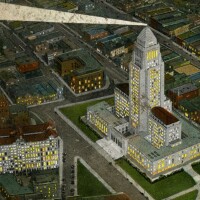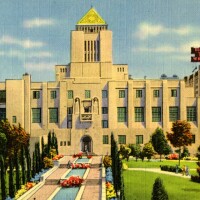Los Angeles in Buildings: Scientology Pacific Area Command Base

It isn't always obvious who owns Los Angeles' notable old buildings, but 4833 Fountain Avenue requires no research more intensive than an upward glance. There, in sixteen-foot letters, its current stewards have mounted — lest the symbolism of the eight-pointed cross at the tip of the rooftop pyramid prove too obscure — the word "SCIENTOLOGY." Every Angeleno's list of quintessential Los Angeles experiences differs, but mine includes brunching across the street from that sign, mimosas and migas enjoyed under its looming presence as well as the blue paint job (which, unsettlingly, sometimes matches the sky) and mammoth scale (at least compared to the blocks of Hollywood around it) of the building holding it aloft.
Then there's another, even more palpable presence: that of security, not just in the form of endlessly looping, bicycle-mounted security guards, but cameras installed in countless positions both seen and no doubt unseen. That will surprise nobody even casually familiar with the public profile of the Church of Scientology, owner of 4833 Fountain and at least 25 other properties across Hollywood. Members who defect and publicly tell their stories have drawn stern responses from the organization, to say the least, as have investigative journalists who try to find just what goes on behind the azure walls of the building Scientology officially calls its Pacific Area Command Base, or more casually, "Big Blue."
Though the information those ex-Scientologists and reporters have come out with suggests that its doctrine deals with events going back trillions of years, the Church of Scientology itself was founded relatively recently, in 1954, by science-fiction writer L. Ron Hubbard. Having made his first journey out to Los Angeles to write for the movies in the mid-1930s, the Nebraska-born Hubbard worked on "Dianetics," which would become Scientology's foundational text, in an office on Sunset Boulevard during the 1940s. At the time of the book's publication in 1950, he'd opened an operation called the Hubbard Dianetic Research Foundation on Hoover Street. Despite having lead a fairly peripatetic life up to that point, he seemed to have adopted Hollywood as his own neighborhood.

By that point, Hubbard must have had ample opportunity to admire the building that would one day come to represent his religion, built as it was just a few years before he first arrived. It had religious significance from the outset: then known as Cedars of Lebanon Hospital, it opened in 1930 as the successor to Boyle Heights' Kaspare Cohn Hospital, which itself had begun in Angelino Heights in 1902 as a facility for Jewish tuberculosis patients. Before merging with Mt. Sinai Hospital in 1976 to become the world-famous Cedars-Sinai Medical Center, Cedars of Lebanon could count among its many individuals to whom it provided treatment such Hollywood icons as Errol Flynn, Marilyn Monroe, Burt Lancaster, and Mae West.
The fact that such eminences had all checked in wouldn't have been lost on Hubbard, who understood the considerable value the famous — those, he once wrote, "to whom America and the world listens," those who carry "most of the enthusiasms on which the society runs" — to a cause like his. Surely he appreciated the old-Hollywood élan of the architecture by Claude Beelman, who in his career proved himself in not just the Art Deco style of Cedars of Lebanon but Beaux-Arts before it and Streamline Moderne after. Whatever the specifics of its appeal, the hospital became one of the first few big acquisitions the Church of Scientology made when it started buying historic Hollywood buildings, beginning in 1973, a couple of miles away on Franklin Avenue, with the Château Élysée — now known as Scientology's "Celebrity Centre."
These purchases, the Château Élysée for $1.5 million and Cedars of Lebanon for $5 million, show a certain financial savvy on the part of Hubbard and his organization. "By the time the Church began to buy on Hollywood Boulevard, most other investors had fled, and the street belonged to dealers, runaways, and bums," writes the New Yorker's Dana Goodyear. "Tourists came on coaches, saw the Walk of Fame, and got straight back on the bus. The Church of Scientology was one of the few things going; often, in those days, theirs were the only lights on after dark." Not only did they know an opportunity to buy low when they saw it, they sensed a potential missed by many Los Angeles urbanists of the day: not only that the dilapidated area could generate more foot traffic, but that it could draw an even higher proportion of out-of-towners and new arrivals, valuable segments of society for a group always on the lookout for new recruits.
The lives of both Hubbard and the Ohio-born Beelman, who came west during the building boom of the 1920s and became prominent in his field with works known for qualities other than their reserve (the turquoise Eastern Columbia Building downtown, for instance, now converted into lofts), fit that classic Los Angeles pattern nicely. Throughout his more than forty years working here, Beelman realized a series of glamorous visions suited to several eras of the aesthetically evolving city in a row, and that glamour has become just as invaluable a resource for a church with an appeal rooted in the mythology of the golden age of Hollywood as it was for Hollywood itself in that golden age, back when that same mythology ensured its very survival.
Both Hubbard and Beelman arguably tapped into, and did their parts to strengthen, a spirit of Los Angeles only still only inchoate when they got here. "There is no reward for aesthetic virtue here, no punishment for aesthetic crime; nothing but a vast cosmic indifference, and that is the one thing the human imagination cannot stand," wrote James M. Cain in 1933, describing the works of architecture he then saw in Los Angeles as "feverish and idiotic excursions that have neither reason, rhyme, nor point, and that even fail in their one purpose, which is to attract notice." As for the city's many rumored "nutty religions," they struck him as "more like pastimes than the religions you are probably accustomed to. People find in them a relief from boredom, give them the zealous attention that a fad might command elsewhere."
Then came the mid-twentieth century, and with it the bold architectural styles that caught the world's attention by flowering in (and, in a sense, defining) southern California as well as the truly formidable homegrown creeds, of which Scientology rose to become the richest and best-known. The plentiful donations of its members, combined with its tax-exempt status as a religious organization granted after a quarter-century locked in struggle with the IRS, gives the church an incentive to spend and spend big, not just on real estate purchases but on preservation projects as well. This has drawn plaudits from the city's preservationists, who have come to see Scientology, whatever its other aims, as a force for good — "good" meaning, as it so often does in these cases, keeping as much of Los Angeles as possible looking as it did at about the time of the Second World War.

Still, Scientology has also put its own stamp on these historic buildings, and not just with oversized signage. Through the Pacific Area Command Base complex, which now comprises ten structures, runs the brick-paved "L. Ron Hubbard Way," so renamed in 1996 after a successful bit of Scientological lobbying. Though some dissenting voices expressed rather dim views of the decade-dead Hubbard and the unusual church he founded, few could deny that Scientology's outwardly squeaky-clean presence seemed, over the previous twenty years, to have tamed a great deal of the chaos of what had been nervously regarded as some of the sketchiest streets in Los Angeles — or that the same properties in other hands could easily have turned into nothing more distinguished or inspiring than mini-malls.
Yet Scientology's rehabilitation projects have never quite drawn the respect of the larger architecture and design worlds, which seem to see them as kitschy in much the same way as the larger science-fiction world does L. Ron Hubbard's novels. Goodyear describes the buildings as "a visually stimulating mash of old Hollywood and seventies-style art direction and signage," quoting even a member of the group Hollywood Heritage as saying that “subtlety was never really something I noticed with their work.” For all its photographability — at least for photographers who manage to elude those hard-pedaling patrols — Big Blue's defining features are exactly those. And apart from certain operations like the Renaissance restaurant at the Celebrity Center, they suffer the public-relations hindrance of not being open to the public, or the portion of the public disinclined to undergo one of the free "stress tests" offered so eagerly by Scientology's recruiters.
Those recruiters aren't as frightening as they used to be; nor, especially after the exposés and high-profile defections of recent years, is their church. But Scientology still has its notable buildings, all of which still stand as imposingly and spotlessly (at least by Hollywood's standards) as ever, looking every inch — and despite the occasional questionably chosen color or design motif — the grand, private fortresses of old Los Angeles. But the Hollywood they embody and deliberately evoke, that magnet for unformed Midwestern hopefuls and New Age-inclined seekers, will before long pass out of living memory. Into the local riot of unorthodox faiths has, after all, lately arrived a belief in Los Angeles itself, not as a constellation of neighborhoods or an accretion of new arrivals on the make, but as a coherent city.





